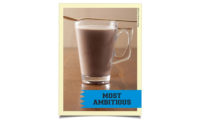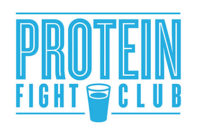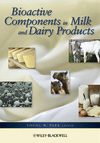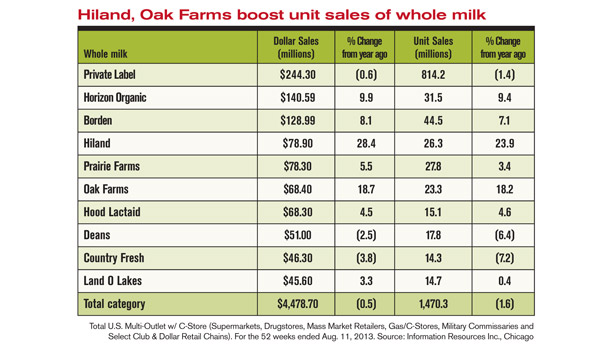Dairy industry trend: milk touts its protein advantage








The gallon jug is dead. Long live the gallon jug.
The International Dairy Foods Association noted that “per capita consumption of fluid milk products declined in 2011 by 6.2 pounds or 0.71 gallons. The 174.3 pounds (20.3 gallons) of fluid milk products consumed in 2011 was the lowest level of per capita consumption on record.”
Due to declining family sizes and dining habits, the plastic jug on the breakfast table is not as relevant as it was a generation ago. Breakfast for many Americans is eaten on the go, if eaten at all.
Read the entire Industry Outlook
Fluid milk processors have taken note. They have turned to alternative packaging and alternative channels of distribution. (Most milk is sold in gallon containers at food and drug stores.) Talk to any processor and the adjective “to-go” comes up. Resealable bottles containing 10 to 16 ounces are gaining favor. So are smaller, 8-ounce aseptic packages. Processors place these packages in convenience stores.
Milk, the most basic and least processed product in the dairy food group, is undergoing changes. Dairy processors have expanded their view who buys milk. Seeing the potential in export markets, especially China, milk processors have invested in aseptic technology so they can ship milk long distances without the need for refrigeration.
Tom Gallagher, chairman of Dairy Management Inc., Rosemont, Ill., said dairy farmers told him that they are ready to produce more, but they want to know if the fluid-milk processing industry was committed to milk. DMI is an organization of milk producers funded by the national dairy checkoff program.
In extensive conversations with companies involved in milk, DMI found new players who are “ramping up investment in fluid milk,” Gallagher said. DMI is helping processors with product development and testing of fresh, extended shelf-life and shelf-stable (aseptic) products. These companies are serious about milk, Gallagher said. He noted that it can cost $30 million to introduce a brand, followed by millions more for marketing. That’s on top of the costs invested in plant infrastructure.
One nondairy food company with a dairy product is cereal maker Kellogg Co., Battle Creek, Mich. Its new Kellogg’s To Go is sold in 10-ounce bottles (and as a powder to be mixed with skim milk) containing a “protein blend” consisting of water, nonfat milk, whey protein concentrate and soy protein isolate. A serving has 190 calories and 10 grams of protein (20% of the Daily Value). The shelf-stable beverage is not labeled as milk.
“We are using cereal equities to help drive our growth in some of the noncereal spaces. So, for example, leveraging the Kellogg master brand to launch the Kellogg to-go beverages in the U.S. That enables us to have a more efficient investment model, so we don’t need to add a significant amount of additional brand building in order to drive that growth as it halos back on the cereal business as well,” said Kellogg President and CEO John A. Bryant in an earnings call with analysts this summer.
Dairy to-go
Many dairies package milk in single-serve bottles. Milk processors need to offer “grab-and-go” dairy items because that’s how this nation eats. About one in five Americans eat on the go, and to these consumers it doesn’t matter whether they consider it a meal or a snack. A survey by the Chicago-based market research firm Information Resources Inc. (IRI) found that 21% of Americans grab food and drink throughout the day as the opportunity arises. IRI calls those who eat on the run “opportunists” (compared to the 79% of Americans who eat three square meals a day. IRI calls this segment “the planners”).
Grab-and-go beverages are growing at a far higher rate than the beverage category as a whole, according to TetraPak, a supplier of aseptic packaging and processing equipment based in Vernon Hills, Ill. Citing figures from IRI, Tetra Pak Vice President of Marketing and Product Management Suley Muratoglu noted that energy shots and drinks (the single largest grab-and-go beverage segment) represents one-third of the entire beverage market.
It’s worth noting that retailers have to sell eight pints of milk to equal the volume of a one-gallon container. But on the other hand, the total dollar value of eight pints is greater.
Still, that’s not to say processors can’t find success with larger packaging. By no means is the 76-ounce jug by Kemps a portable container. The plastic cow-shaped jug introduced this year by Kemps, St. Paul, Minn., is easier for children to handle, said Cindy Sorensen of the Midwest Dairy Association. Kemps uses the bottle for its chocolate- and strawberry-flavored milk.
Nutrition and consumers
Whether it is because of obesity, the rise of diabetes or their desire to live a healthier life, consumers are becoming more educated about food and nutrition.
“Consumers care about what they put in their bodies,” said Amy Hendel, a registered physician assistant and consultant to the United Soy Board.
The United Soybean Board’s 20th annual “Consumer Attitudes about Nutrition” found that 35% of those surveyed said say they would order soy products at restaurants if available; specifically soy milk and veggie burgers.
Soy-milk and other nondairy plant-based milks stick in the craw of many dairy-milk processors because these beverages are able to call themselves “milk” without having to conform to the government’s standard of identify for milk. And unlike dairy-milk processors, the plant-based milk processors do not have to pay prices set by the federal Milk Marketing Orders program.
Another irritant to the dairy industry is seeing the word “protein” attached to packages of processed snack bars and other foods. That has led to an industry-wide coordinated campaign to make protein a talking point in any conversation about cow’s milk.
Protein is the new calcium
The dairy industry successfully linked milk to calcium to bone health, said Sorensen. Now the industry wants consumers to link dairy protein with muscle building. The timing is right.
Baby boomers are concerned about protein, said Carrie Schroeder, who works in the U.S. office of Fonterra, a global dairy ingredients company headquartered in New Zealand. The company surveyed consumers age 50 and older worldwide about their attitudes and knowledge of health and nutrition. Fonterra found that 59% of so-called “Active Seekers” in the United States seek high-protein products, compared to 49% globally. These Active Seekers are predominately female (60%), driven to make changes for health benefits and the most affluent segment of those surveyed.
Americans do not eat enough protein. In a statement about its survey, Fonterra said “breakfast (in the USA) is the most protein-deficient meal, presenting the largest opportunity to increase protein intake and spread consumption across the day.”
That fact is not lost on the Milk Processor Education Program(MilkPEP), Washington, D.C. MilkPEP developed a campaign called Protein Fight Club to call attention to milk’s protein content (8 grams in 8 ounces). Using television advertising and videos on its website, MilkPEP pits milk against other breakfast foods, including omelets, orange juice and other dairy foods (cream cheese and yogurt). Predictably, milk wins every round.
Since launching Protein Fight Club in August, MilkPEP said the campaign garnered more than 1.16 billion total impressions by mid-October and the commercials have been viewed 2.5 million times.
Fonterra offers a range of ingredients, including whey protein concentrate, whey protein isolate, milk protein concentrate and milk protein isolate. The question Schroeder asked is, “How do we message protein?”
“We see processors recognizing the power of protein to include dairy as a key method of delivery,” said Jim Dimataris, director of processor relations for the California Milk Advisory Board. “The protein content has made its way to the front of many packages so the consumer can quickly identify a protein source they may not be familiar with.”
He noted that protein labeling is most popular on yogurt and drinkable yogurt packaging. Dimataris said some processors are marketing higher-protein milk in white and chocolate as a “dairy beverage.”
Dallas-based Dean Foods Co.introduced a protein-enhanced milk in California, Nevada and Hawaii this year. A 14-ounce single-serve bottle of TruMoo Protein milk contains 25 grams of protein. The extended-shelf-life product is available in chocolate, vanilla, strawberry and cookies n’ cream flavors.
Lucerne, a dairy brand of grocer Safeway, Pleasanton, Calif., introduced Protein Plus dairy beverage with 12 grams of protein in an 8-ounce serving. Another Dallas-based dairy, Borden’s, sells Hi Protein 2%. It has 10 grams of protein in an 8-ounce serving. And promoting protein is old hat for Des Moines, Iowa-based dairy processor Anderson Erickson Dairy.
“We have called out protein in milk for a number of years,” said Director of Marketing Kim Peter.
Beyond the private label
Private-label milk beats branded milk every time in the supermarket. The opposite is true in Canada, where consumers are loyal to their branded milk, said Eric Jacobson, marketing manager for Agropur in Minneapolis. Agropur is a Canadian dairy cooperative.
A study by The Integer Group and M/A/R/C Research shows that 61% of those surveyed buy private-label milk in the United States.
If DMI’s Gallagher had his way, processors and retailers would stop undercutting the price and making milk a commodity. “There is room for everyone,” he said.
The irony is that branded milk processors are often the ones manufacturing private-label milk because they have the processing expertise and the excess capacity on their production line.
Milk processors are doing their best to add value to distinguish their brands from store brands so they don’t compete on price. For example, they might make a quality claim, like Oregon’s Umpqua Dairy Products Co., Roseburg, Ore., which guarantees its milk is fresh five days past code date.
Other processors add calcium, Omega-3s or protein (like Dean Foods) or remove lactose. The dairy industry continues to address the lactose issue. It feels that many consumers wrongly self-diagnose themselves as lactose intolerant. This year, the National Medical Association issued an Updated Consensus Statement. It reads in part: “It is important for both African Americans and Hispanic Americans with lactose intolerance to meet nutrient recommendations and it is also essential for healthcare providers to recommend that their lactose intolerant patients consume dairy foods daily.”
Probably the best example of value-added milk is organic milk. In early September, the USDA reported the price difference between a half-gallon of organic and conventional milk was $2.19.
Organic Valley, La Farge, Wis., added a lactose-free whole milk SKU at the request of its customers. The co-op had been selling a reduced-fat version. Also this year, Organic Valley upped the ante with organic milk from grass-fed cows.
Flavors and sweeteners
Flavors are another way for dairy processors to make a splash. According to the Dairy Foods 2013 Ingredient Study, 81% of milk processors plan on using strawberry. Other top flavors are mango (57%), cherry (45%) and blueberry (43%). Banana, pineapple and raspberry all came in at 41%. Chocolate was not offered as a flavor choice in the survey, but 55% of milk processors did say they will increase spending on “other” ingredients, which include chocolate and cocoa, along with fruits, nuts and juices.
Tulare, Calif.-based Top O’ The Morn Farms introduced reduced-fat Root Beer milk to its line in July. The home-delivery processor sells the milk in quart glass bottles for $3.19. Each bottle contains 4.5 grams of fat and 7 grams of protein per serving.
Anderson Erickson Dairy, at the request of its customers, developed a stevia-sweetened, fat-free, sugar-free flavored milk sold in half-gallons. Adding sweeteners to milk, especially flavored milk, still riles up parents, some of whom seek to remove it from elementary school menus. Perhaps parents would serve their children better by looking in the pantry at home.
“More added sugars calories were consumed at home rather than away from home,” noted a report by the U.S. Department of Health and Human Services. The report, which crunched numbers from the National Health and Nutrition Examination Survey, also concluded that “more added sugars calories came from foods rather than beverages.”
The future of milk
Dimataris of the California Milk Advisory Board said there are “a great many opportunities for growth in the domestic and international markets for dairy products. ESL milk is a growing category both domestically and internationally as is UHT (ultra-high temperature) milk due to its ability to be shelf stable up to one year.”
MilkPEP’s position is to “defend breakfast,” the time of day when most milk is consumed. It notes that 51% of milk is consumed at breakfast and sees breakfast as an $8.9 billion growth opportunity. Its chocolate-milk Refuel campaign takes aim at the $3.3 billion sports-drink industry with the intention of getting athletes to drink chocolate milk instead of Gatorade or similar products after working out.
Another so-called “usage occasion” is right before bedtime. The California Milk Processor Board in April ran television commercials suggesting that a glass of milk before climbing into bedtime promotes sweet dreams. The 30-second surrealistic ads ran in Spanish and English.
But Gallagher of DMI suggested that the milk industry needs to promote the consumption of milk in social settings, not just at breakfast, which he calls a private setting. That’s a tactic taken by nondairy beverages as diverse as soft drinks, juices and alcoholic beverages.
Is the gallon jug of milk really dead? No, but the national trend is not promising. Perhaps geography is destiny.
“We still have a lot of people drinking milk” in Iowa and the Midwest, said Anderson Erickson’s Peter.
10 unusual flavors of milk
| Flavor | Processor |
| 1. Caramel chocolate milk | Winder Farms |
| 2. Root beer | Top O the Morn |
| 3. Dark chocolate milk | Natrel (Agropur) |
| 4. Coffee milk | Oakhurst Dairy |
| 5. Cotton candy | Shatto Milk Co. |
| 6. Lime | Primo (Fonterra) |
| 7. Marshmallow | Emmi |
| 8. Vanilla malt | Rush (Parmalat) |
| 9. Hazelnut cocoa | Nöm |
| 10. Cinnamon vanilla | Promised Land |
Source: Dairy Foodsresearch
Looking for a reprint of this article?
From high-res PDFs to custom plaques, order your copy today!













